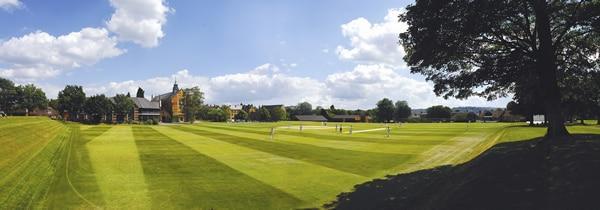In 1826 the Governors of Tonbridge School purchased a field next to the school from Mr. Martin. This ground was levelled in 1838, using earth and workmen from the new railway then being built through Tonbridge, and became The Head and the Upper and Lower Hundreds. The famous Dodd painting of cricket at Tonbridge is dated 1851, but the first inter-school match was against Brighton College in 1856 and the current pavilion was built in 1860. In 1876 the school played MCC for the first time.
In the 1880s C.J. Kortright was in the school team going on to become the fastest bowler in England, but the greatest Tonbridge cricketer of this period was K.L. Hutchings, who made 126 for England against Australia in Melbourne in 1907. In the period after the First World War the names of L.P Hedges and C.H. Knott stand out, both of them Oxford and Kent cricketers, who in 1919 shared a stand of 396 against Lancing. In the 1930s J.G.W. Davies earned fame as a Cambridge undergraduate by bowling Bradman for a duck and went on to play for Kent, as did T.A Crawford while J.R. Thompson played for Warwickshire.
The second Tonbridgian to make a century against Australia was M.C. Cowdrey, certainly the most distinguished cricketer the school has produced. He had a remarkable school record of 2894 runs and 216 wickets over five years and went on to captain Kent and England and become a hugely respected administrator of the game as Lord Cowdrey of Tonbridge.
Following Colin Cowdrey another four Tonbridgians have played for England ? Roger Prideaux, Chris Cowdrey, Richard Ellison and Ed Smith. All of these played for Kent, although Prideaux also went on to captain Northants and Smith is the current captain of Middlesex. Chris Cowdrey, like his father, captained England and Richard Ellison will be remembered for the way he bowled out the Australians to win the Ashes in 1985
The association of Tonbridge with Kent County Cricket Club has been a long and enduring one. In recent years, apart from those above, Graham Cowdrey played many games for the county, while others to have played are Nick Kemp, Jonny Longley, Chris Walsh and Matt Banes. Mark Allbrook played for Nottinghamshire and James Pyemont for Derbyshire.
Not surprisingly this roll-call of fine cricketers has meant that the Old Tonbridgians have been the dominant team in the Cricketer Cup, winning the competition thirteen times, more than twice as many as the next school, Malvern. This includes six victories in the last ten years under the captaincy of Jonathan Arscott. The first round in 2008 is away at Repton on 15 June.
Until the late 1960s the climax of the school season was a two-day match at Lord?s against Clifton, but this has now been replaced by an end-of-term festival which started at Eastbourne in 1970 and has now assumed a more international feel at Tonbridge in the week after term ends. This year we are hosting Bishop?s from Cape Town, Prince Alfred College from Adelaide and Millfield School, now coached by Richard Ellison. The term fixtures are much stronger now with the relatively recent additions of Eton, Harrow, Wellington, Charterhouse and Radley with whom we compete for the Cowdrey Cup.
There are many fine cricketers who have served the school as cricket professional or masters. Maurice Tate was the professional briefly after the war, while Ray Dovey and Alan Dixon of Kent played a major part in producing the fine sides of the 1970s. John Inverarity of Australia taught Maths at Tonbridge in the 1970s, while Derek Chadwick from Western Australia spent five happy years here recently as coach. Test players currently on the staff are Andy Whittall of Zimbabwe and Paul Parker of England. C.H. Knott returned to his old school in the 1930s to run the cricket and was succeeded by Mike Bushby in 1954 who in turn handed on to David Walsh in 1972. Simon Doggart, Ian MacEwen, Paul Taylor, Nathan Leamon and James Hodgson have produced some excellent sides since 1990.
Tonbridge cricket is also strongly associated with the Yellowhammers Cricket Club, which celebrates its centenary in 2009. It was founded by Leonard Marzetti who wanted a week?s holiday cricket with his Tonbridge friends. David Walsh took over the Presidency from Richard Gracey in 2006. The Yellowhammer week starts this year on 20 July and includes matches on The Head against the Arabs and MCC.
There are not many better grounds in England than The Head, lovingly tended by many dedicated groundsmen, with George Alexander now in charge. Its position in the centre of the school and right beside the Chapel has helped to maintain the popularity and success of the game at Tonbridge. Every boy who plays here becomes part of a rich and celebrated cricket history.
Directions
Please download the directions to Tonbridge.
Further information can be found at www.tonbridge-school.co.uk.
